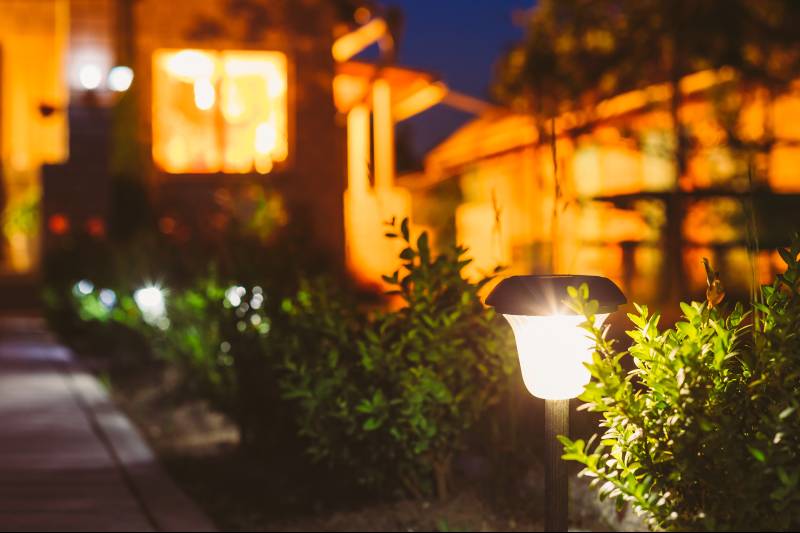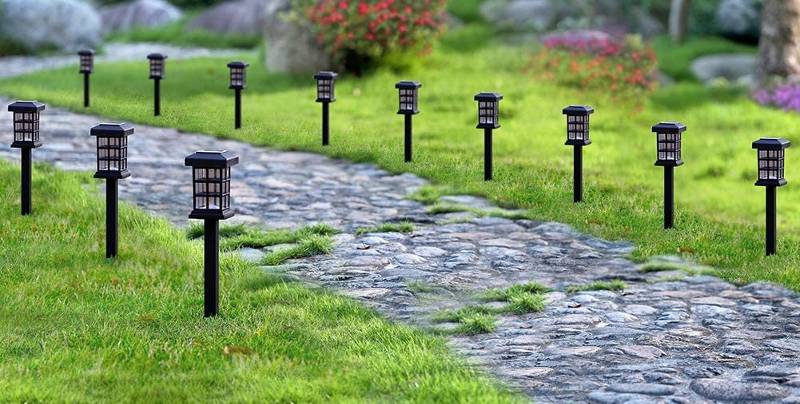Solar lights are a popular choice for outdoor lighting, offering an eco-friendly and cost-effective solution.
But what about their performance on cloudy days? Do solar lights still charge when the sun is obscured by clouds?
The answer is a resounding yes! Solar lights can charge on cloudy days, however, they won’t be able to produce enough energy to last all night.
In this article, we will explore how solar lights work, the impact of cloudy days on solar energy, and tips to improve solar light charging during overcast conditions.
How Solar Lights Work
1. Solar Panels
Solar lights function by harnessing energy from the sun through solar panels. These panels contain photovoltaic cells that convert sunlight into direct current (DC) electricity.
This energy is then stored in the solar light’s battery for later use.
Related Article: How Solar Lights Work at Night Step by Step
2. Batteries
The energy collected by the solar panels is stored in rechargeable batteries, typically lithium-ion, nickel-metal hydride, or nickel-cadmium.
When the sun sets, and the solar panel stops producing electricity, the energy stored in the batteries powers the light.
3. Light Sensors and LEDs
Solar lights are equipped with light sensors that detect when the surrounding environment becomes dark.
Once darkness is detected, the sensor triggers the LED light to turn on. The LED light is powered by the energy stored in the battery.
Related Article: How Do Solar Lights Turn on Automatically at Night
The Impact of Clouds on Solar Lights
Solar lights do charge on cloudy days, but their efficiency is reduced compared to sunny days. Clouds can block some of the sun’s rays, decreasing the amount of sunlight that reaches the solar panels.
However, solar panels can still capture diffused light that penetrates through the clouds, allowing them to generate electricity, albeit at a lower rate.
Related Article: 10 Ways to Charge Your Solar Lights When There Is No Sun
Factors Affecting Solar Light Charging
Several factors can influence the efficiency of solar light charging on cloudy days:
1. Quality of Solar Panels
Higher-quality solar panels are more efficient at capturing sunlight and converting it into electricity. This means that even on cloudy days, they can still generate a significant amount of power.
2. Condition of Solar Panels
Debris, dust, or any residue on your solar panels can significantly reduce their efficiency, resulting in less electricity output. That’s why it’s crucial to clean your solar lights once every 3-6 months to ensure maximum sun exposure.
3. Positioning and Orientation
The position and orientation of your solar cemetery lights also play a role in their charging efficiency. Ensure that your solar lights are placed in a location that receives maximum sunlight exposure and is oriented towards the sun for optimal charging.
4. Battery Capacity
The capacity of the solar light’s battery affects its ability to store energy. A higher-capacity solar light battery can store more energy, allowing the solar light to function for a longer duration on cloudy days.
5. Seasonal Variation
Seasonal changes can impact the performance of solar lights. During winter, the sun is lower in the sky, and days are shorter, resulting in less sunlight for solar lights to charge.
Additionally, cloudy days are more common during certain seasons, which can further impact charging efficiency.
Tips to Improve Solar Light Charging on Cloudy Days
1. Proper Placement
To optimize solar tiki lights charging on cloudy days, ensure they are placed in an area with the best possible exposure to sunlight.
Avoid placing them under trees, eaves, or other structures that could block sunlight. Even on cloudy days, open spaces can receive more diffused light compared to shaded areas.
Related Article: How to Enhance The Brightness of Your Solar Lights
2. Regular Maintenance
Regularly clean the solar panels on your solar rope lights to remove dust, dirt, and debris that may accumulate over time.
A dirty solar panel can reduce its efficiency in converting sunlight to electricity, further impacting charging on cloudy days. Also, check the battery regularly and replace it when necessary to maintain optimal performance.
3. Using High-Quality Solar Panels and Batteries
Investing in high-quality solar panels and batteries can improve the efficiency of your solar street lighting solutions, even on cloudy days.
Higher-quality components can help capture and store more energy, ensuring your solar lights continue to function effectively during overcast conditions.
FAQs
Do solar lights need direct sunlight to charge?
Solar lights charge most efficiently in direct sunlight, but they can also charge using diffused light on cloudy days. The charging efficiency will be lower on cloudy days compared to sunny days, but the solar lights will still collect and store energy.
How long do solar lights need to charge?
On a sunny day, solar lights typically need around 6-8 hours of sunlight to fully charge. On cloudy days, charging time may be longer due to reduced sunlight exposure.
Can I charge solar lights indoors?
While solar lights can charge indoors near a window with sunlight exposure, their charging efficiency will be significantly lower than when placed outdoors.
It is best to place them outside to maximize sunlight exposure unless your solar lights are specifically made for indoor usage.
How can I extend the runtime of my solar lights on cloudy days?
To extend the runtime of your solar lights on cloudy days, ensure proper placement for optimal sunlight exposure, maintain the solar panels and batteries, and invest in high-quality components.
These steps can help improve the charging efficiency of your solar lights even on overcast days.
How long will a fully charged solar light last?
A fully charged solar light can typically last between 8-10 hours, depending on the battery capacity, LED brightness, and other factors. The runtime may be shorter on cloudy days due to reduced charging efficiency.
Conclusion
While solar lights do charge on cloudy days, their efficiency is reduced compared to sunny days.
However, by understanding how solar lights work and considering factors such as solar panel quality, positioning, battery capacity, and seasonal variations, you can improve their charging efficiency.
By following the tips provided, you can maximize the performance of your solar lights, even when the sky is overcast.





